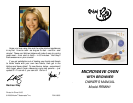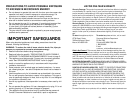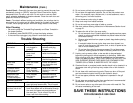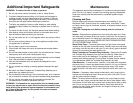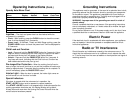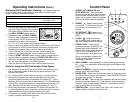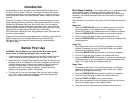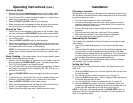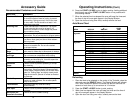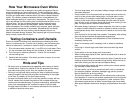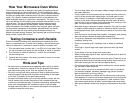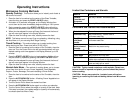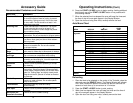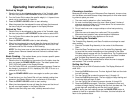
4 21
Additional Important Safeguards
WARNING: To reduce the risk of injury to persons:
1. Do not use narrow necked containers to boil or reheat liquids.
2. To prevent delayed eruptive boiling of hot liquids and beverages or
scalding yourself, stir liquid before placing the container in the oven
and again halfway through cooking time. Let stand in the oven for a
short time and stir again before removing the container.
3. The liquid may splash out during or after heating or when adding
ingredients (instant coffee, etc.) resulting in possible harm or injury to
persons.
4. To reduce the risk of injury, stir the liquid several times before heating.
5. After heating, allow the container to stand in microwave oven for at
least 40 seconds before removing the container.
6. Do not heat water and oil, or a fat together which may cause a violent
eruption.
7. Do not store anything directly on top of the appliance surface when
the appliance is in operation.
8. Do not deep fry food in the microwave.
9. Pierce foods with heavy skins such as potatoes and squash before
cooking.
10. Do not heat baby bottles or baby food in the microwave oven. Uneven
heating may occur and could cause physical injury.
11. Cooking utensils may become hot by heat transferred from the heated
food. Use potholders as needed to avoid injury.
12. Use only thermometers which are specifically designed for use in
microwave ovens.
13. Do not operate any heating or cooking appliance beneath this appli-
ance.
14. Be certain the Glass Turntable and Turntable Ring Assembly are in
place when you operate the oven.
15. Do not attempt home canning in this microwave oven, as it is impossi-
ble to be sure all contents of the jar have reached boiling temperature.
16. Do not use this microwave oven for commercial purposes.This
microwave oven is made for household use only
WARNING: It is hazardous for anyone other than a trained person
to carry out any service or repair which involves the removal of any
cover which gives protection against exposure to microwave ener-
gy. If there is any damage, do not operate the oven and contact
Consumer Relations.
Maintenance
This appliance requires little maintenance. It contains no user-serviceable
parts. Do not try to repair it yourself. Any servicing requiring disassembly
other than cleaning must be performed by a qualified appliance repair
technician.
Cleaning and Care
Routine cleaning will enhance the performance and reliability of your
Microwave Oven. Clean the oven on a weekly basis, more often, if need-
ed. Never use any type of chemicals, solvents, or abrasive cleaners on the
oven surface.
CAUTION: Unplug the oven before cleaning exterior surfaces or
vents.
Interior - Wipe spills and splatters from the interior after each use. Clean
with mild soap and water. Rinse and dry with a soft cloth. Do not use any
type of abrasive cleaner. For heavier soil, use baking soda or a mild soap;
rinse thoroughly with hot water. NEVER USE OVEN CLEANERS INTEND-
ED FOR CONVENTIONAL OVENS.
Wave Guide Cover - The wave-guide cover is a light brown mica panel
located on the right side of the oven interior. Carefully clean with mild soap
and water; rinse and dry with a soft cloth. Do not use any type of abrasive
cleaner. Do not remove the wave-guide cover.
Glass Turntable and Turntable Ring Assembly - Remove the Turntable
and Turntable Ring Assembly from the oven for cleaning. Wash them in
warm water using a mild detergent. For stubborn stains, use a mild
cleanser and scouring sponge. Only the Glass Turntable may be washed
in the dishwasher. Wash the Turntable Ring Assembly by hand.
Odor Removal - To remove odors: combine 1 cup water with the grated
peel and juice of 1 lemon and several whole cloves in a 2 cup, microwave-
safe, glass measuring cup. Boil for several minutes using 100% power.
Leave the liquid in the oven until it cools. Wipe the interior with a soft, dry
cloth.
Exterior - If necessary, clean exterior surface with a soft, damp cloth or
sponge and mild soap and water. Rinse and dry with a soft cloth. Do not
use any type of abrasive cleaner.
Door - To ensure safe and efficient operation, be sure to keep the inner
door, door seal, hinges, and latches clean and free of food residue. Wipe
the window on both sides with a damp cloth to remove any spills or splat-
ters. Do not use any type of abrasive cleaner. Gently wipe around the
inside of the door frame, seals, latches, and hinges to remove any food
particles and condensation.



